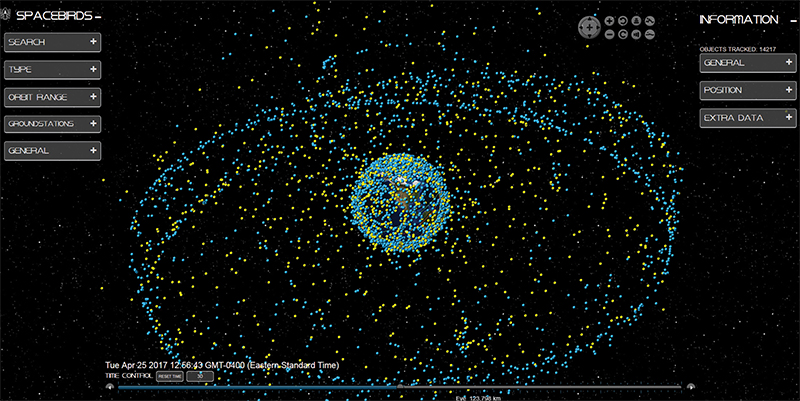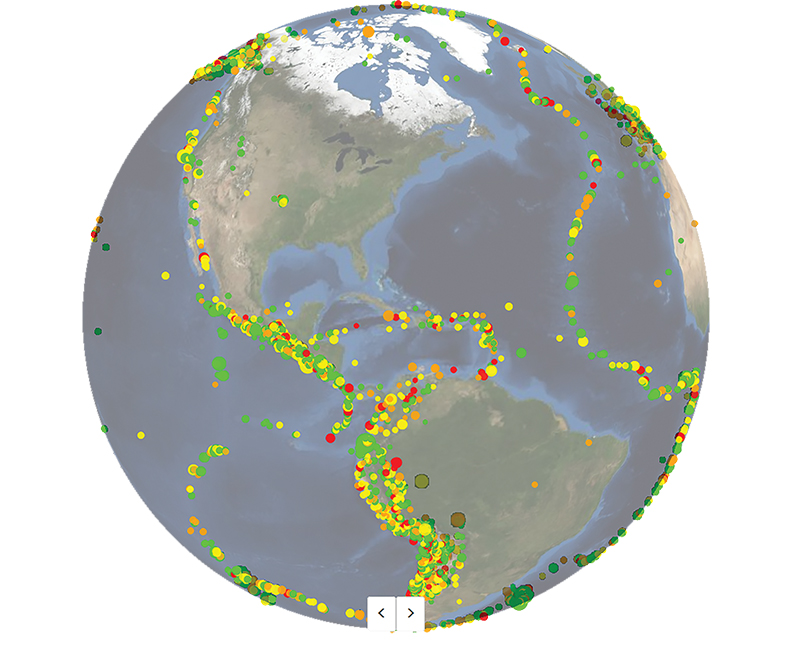
Quake Hunter Maps a Century of Quakes Worldwide
NASA Technology
Earthquakes are among the most destructive natural disasters, in terms of death tolls and the cost of recovery. They’re also nearly impossible to predict, but seismologists and amateurs alike now have another tool to help them better understand the behavior of the planet’s crust. An open source virtual globe originally developed by NASA as an education tool and used by countless government agencies, nonprofit organizations, and commercial entities around the world now provides the ability to track and visualize 100 years’ worth of global earthquake data.
Like many capabilities added to World Wind since it was introduced in 2003, Quake Hunter wasn’t created by NASA engineers. In this case, NASA interns developed the application.
“I had access to extraordinary talent,” says Patrick Hogan, World Wind project manager at NASA’s Ames Research Center, referring to the international group of computer science students who were nominated through the NASA I2 Project and competitively selected by NASA to support World Wind during the summer of 2016. “These were the best students their countries had to offer. I was very fortunate to have them all in the same place at the same time to support this valuable project.”
The original World Wind, created under NASA’s Learning Technologies Program, was a standalone application much like Google Earth, except it preceded the tech giant’s product by a couple of years.
It was released under the NASA Open Source Agreement in 2004 and, after moving to SourceForge the next year because NASA’s servers couldn’t handle all the traffic it generated, the app saw days of almost 100,000 downloads. With access to the source code, users created hundreds of add-ons to let others explore other planets and moons, follow the Tour de France, track disease outbreaks, or find the locations of castles.
In 2006, a Java-based World Wind software development kit funded by the U.S. Department of Energy made it easier for users to base their own apps on the software. Government agencies snapped it up. The Federal Aviation Administration is building its next-generation air traffic control system with it. The United Nations uses it to track locusts. The Department of Defense is perhaps the biggest user, with many of its branches and agencies using it to manage operations. The European Space Agency recently embedded a group of software developers on the Ames World Wind team to drive further improvements to the web version of World Wind. Major corporations have provided funding over the years, either for features to be added to the kit’s core or for assistance in developing their own World Wind-based apps.
Technology Transfer
In 2016, Hogan was considering World Wind projects his interns could pursue. He had seismology on the brain because he’d recently been working with high school students in Alaska to use World Wind to record, dynamically visualize, and archive data for local anomalies in Earth’s magnetic field preceding seismic activity, in hope of being able to forecast earthquakes.
“There’s this rich seismic data, and I thought, man, let’s do something with that,” he recalls.
Hogan also had recently received support from the U.S. Geological Survey (USGS), where that historical earthquake data resides, to allow subsurface data to be visualized in World Wind. The Geological Survey was interested in mapping underground features like wells, fault lines, and aquifers, but this capability would also let the earthquake-mapping application pinpoint not just a quake’s epicenter but its hypocenter—the spot within the earth where the rupture occurs. “We only went inside the earth because we could, and we only could because of the USGS,” he says.
Starting with this newly enabled model of Earth, the students used USGS data to map every quake in the last century. The Quake Hunter web app is available for download, with source code or not. The user can filter quakes based on a geographic area and ranges of dates, magnitudes, and depths. Quakes are represented by dots of different sizes and colors depending on their magnitude and the date range they fall into. By viewing the planet at an angle, the user can see the depths of quakes’ hypocenters.
Hogan notes that his interns succeeded despite this being their first time writing in JavaScript, which he called a testimony to both their ability and World Wind’s ease of use.
They also managed to build two other World Wind-based apps that summer—SpaceBirds, which tracks the location of 15,000 or so satellites in Earth’s orbit, and WorldWeather, which maps historical, current, and forecasted weather for the entire globe in three dimensions using multiple globes. All three are available as web apps, along with source code.
Benefits
After Quake Hunter was completed, Hogan shared the work with the director of USGS’s Innovation Center for Earth Science. Observing color-coded dots representing earthquakes in Italy, he noticed the pattern appeared to be moving northward and correctly predicted the location of the next quake, Hogan recalls. Not all earthquakes are so predictable, but the episode demonstrates some of the value of a visual representation of the planet’s seismic history.
“No one has ever had this degree of immediate access to the data,” Hogan says, noting that, while the data was publicly available, looking at numbers and coordinates on a spreadsheet is not at all like looking at an image of the data in the context of the real world.
From this, patterns emerge. Observing the depths of quakes in a small area over a long period gives a picture of the nature of the fault line. Hogan notes that a user considering buying ain an area like California can see how active the area is or whether a quake is overdue. And for anyone who studies geology and seismic data, he says, “it’s an extraordinary window into the science. It helps us understand not only Earth processes but also where areas of concern are.”
As for SpaceBirds, which pulls satellite location data from the Department of Defense’s SpaceTrack server and visualizes it, Hogan says, “I thought it was just a natural for NASA.”
For the WorldWeather app, he says, team members pulled data from every publicly available weather-related server they could find. The program allows the user to visualize any number of data layers or place two, three, or four globes side-by-side to look for correlations between different aspects of weather, as well as terrestrial data like soil moisture or vegetation classification.
“What’s more interesting than climate change and weather?” Hogan asks, noting that one idea is to help farmers plan watering programs and know what sort of weather they’ll be up against. “It’s just bringing all the free, public sources of that data into one program.”
Some of the interns won funding to go on to create an upcoming CitySmart app, a suite of tools built on World Wind for urban management. One of several partners in the project, which is still under development, is the city of Springfield, Oregon, which asked the team to map its underground infrastructure, and, Hogan notes, this is now possible due to the same upgrades that let Quake Hunter pinpoint earthquakes’ hypocenters underground. “If we have an open source program in place that allows cities of the world to work together, that would be amazing,” he adds.
“We’re doing things for the world that I think really are for the benefit of all.”

In Quake Hunter, a visualization of about a year’s worth of earthquakes in the Western Hemisphere, between 2016 and 2017, makes the fault lines unmistakably clear.

A visualization of all the satellites in space, as seen with SpaceBirds, another application built on World Wind, reveals dense rings in geostationary orbit and an even denser satellite population just off the planet’s surface in low-Earth orbit. The satellite representations move in real time, and their orbits can be tracked.













